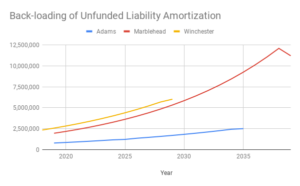A Follow-up on Pension Systems with the Highest Growth Rates in Unfunded Liability
As Pioneer has previously discussed, Massachusetts continues to kick the can down the road with regard to its public pension liabilities. Legislators and municipalities have not only delayed the funding schedules of these pension systems, but have also back-loaded them, leaving the bulk of debt amortization for the future, while only paying small amounts now.
In a recent blog, Pioneer covered the three public pension systems with the highest growth rates in unfunded liability: Adams, Marblehead, and Winchester. Given the alarming increases, we wanted to see if these pension systems were making steps towards improvement– namely, if they planned to tackle their debt now rather than later. Unfortunately, this does not appear to be the case.
Using MassPensions.com, one can see that Adams has continually postponed fully funding its pension liability. In 2012, its target year for full funding was 2030. However, in 2014 it was 2031, in 2016 it was 2035, and by 2018 the target year was 2036. Not only has this system delayed its payments, it has also back-loaded them. In its most recent funding schedule, Adams allotted $793,565 for its 2019 debt amortization payment. After 2019, this allotment increases by an average of 7.5% annually, reaching $2,509,964 in 2035– the final year of amortization payments.
In recent years, Marblehead has also deferred fully funding its pension system. In 2014, the system intended to be fully funded by 2036. However, in 2016, this system extended its target year to 2038. Then in 2018, Marblehead postponed its target year again to 2040. Moreover, like Adams, Marblehead’s pension system is back-loaded. Its most recent funding schedule earmarks $1,960,009 in amortization payments for 2019. These payments eventually grow to $12,106,300 in 2038 and $11,219,218 in 2039, with an average annual growth rate of 9.1%.
Winchester’s pension system follows these trends as well. In 2011, this system had a target year of 2021. Then in 2013, it extended this date to 2029, which it maintained until 2017 when it delayed its target year once more to 2030. Additionally, Winchester has back-loaded its debt amortization payments. Its latest funding schedule appropriated $2,345,597 for these payments in 2018. Following 2018, this amount rises by an average of 9% annually, increasing to $6,027,353 in 2029.

Despite the fact that each system’s unfunded liability has risen significantly in recent years, those who oversee these funds have not properly addressed this issue. Rather, they have continued to set aside significant portions of their debt payments for the future. Moreover, the public has reason to doubt that these towns will even deliver on their planned payments, given each system’s tendency to delay their target year. However, if these communities want to avoid a future pension crisis, then they must change the path they’re currently on. Retirement systems should adopt a more fiscally responsible approach and stop back-loading debt payments and postponing target years; if not, then their taxpayers and pensioners will ultimately pay.
Cole Kroninger is a Roger Perry Transparency Intern at Pioneer Institute. He is a rising senior at Hamilton College where he studies Economics.



